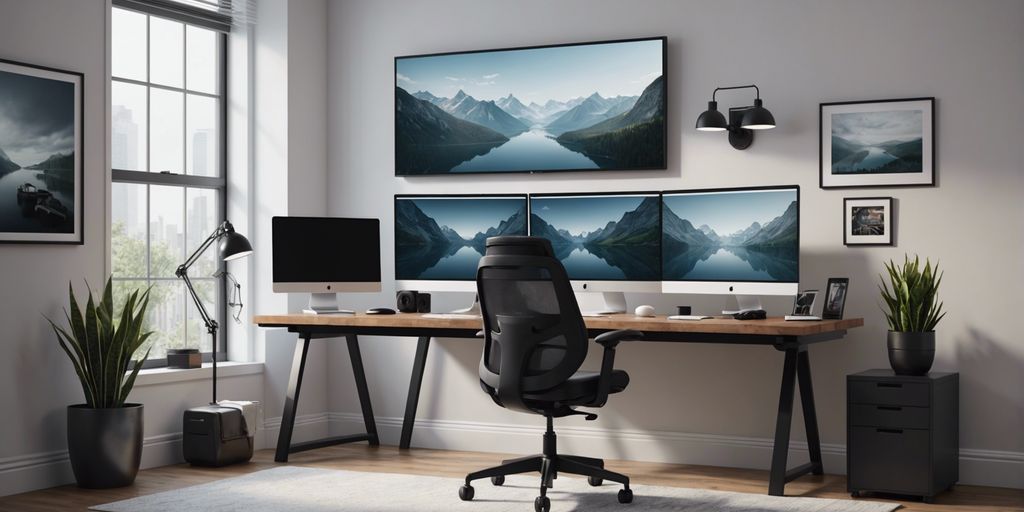Setting up a dual monitor workspace can significantly enhance your productivity and workflow management. By connecting and configuring your monitors, adjusting display settings, and positioning them correctly, you’ll create a functional dual monitor workspace. This setup boosts productivity, makes multitasking easier, and improves workflow management. Experiment with different arrangements to find what works best for you.
Key Takeaways
- Choosing the right monitors involves considering screen size, resolution, and compatibility with your computer.
- Properly connecting your monitors requires identifying available ports and using the correct cables.
- Configuring display settings, such as screen resolution and display orientation, is essential for optimal performance.
- Ergonomic placement of monitors and the use of stands or arms can enhance comfort and workflow.
- Regular maintenance, including cleaning and updating drivers, ensures the longevity and efficiency of your dual monitor setup.
Choosing the Right Monitors
When setting up a dual monitor workspace, choosing the right monitors is crucial for an optimal experience. Here are some key considerations to keep in mind:
Consider Screen Size and Resolution
The size and resolution of your monitors can significantly impact your workflow. For a smooth experience, make sure your monitors match in size, resolution, and color profiles. This avoids distractions and promotes a seamless workflow. Using monitors of the same size and resolution ensures that windows and apps appear the same size on each screen, making navigation easier.
Check Compatibility with Your Computer
Before purchasing new monitors, ensure they are compatible with your computer. Check the available ports on your computer and the monitors. If your computer has USB-C ports, you might want to explore a wide range of USB-C monitors. This will ensure you have the right connections and avoid the need for additional adapters.
Decide Between Flat and Curved Monitors
Flat and curved monitors each have their own benefits. Flat monitors are generally more affordable and easier to arrange side by side. Curved monitors, on the other hand, can provide a more immersive experience and reduce eye strain. Consider your workspace and how you plan to use the monitors when making your decision.
When choosing monitors, it’s also worth considering refurbished options. Refurbished computers, refurbished laptops, and refurbished desktop computers can offer great value without compromising on quality. Plus, you can find excellent deals on used computers in Omaha and used laptops in Omaha.
By carefully considering these factors, you can set up a dual monitor workspace that enhances your productivity and comfort.
Connecting Your Monitors

Identify Available Ports
First things first, make sure your computer has two video ports. If not, you’ll need some extra cables or adapters. Connect each monitor to its video port.
Use the Right Cables
Most computers are able to connect dual or multiple monitors easily by just plugging them into the available ports on the computer. It’s the same way you would set up a single monitor, just with a few more steps after you’ve got everything hooked up.
Connect to the Computer
Once they’re connected, you’ll need to configure your computer to recognize both monitors. On Windows, go to the Start menu, select Settings, then System, and choose Display. In the “Multiple Displays” menu, pick “Extend these displays” to set up your dual monitors. Mac users can do this by opening System Settings and selecting Displays.
Pro Tip: Monitors do not have to be configured to line up exactly side by side; you can move them in any direction to reflect how they are physically arranged.
By following these steps, you’ll have your dual monitor setup ready to go in no time. Whether you’re using Omaha computers or setting up computer printers, having a dual monitor setup can significantly enhance your productivity.
Configuring Display Settings
Now that your monitors are recognized, it’s time to tweak the display settings. On Windows, go to Control Panel, select Display, and adjust the settings to your liking. You can change the resolution, screen layout, and orientation. Arrange your displays by dragging them to match their physical positions on your desk.
Positioning Your Monitors
Proper positioning is key for a comfy and ergonomic setup. Place your monitors at eye level or slightly below to reduce neck and back strain. Align the monitors so the center of each screen is directly in front of you.
Optimizing Your Dual Monitor Setup
Aligning Monitors Seamlessly
To get the most out of your dual monitor setup, you’ll need to optimize the configuration and explore some extra enhancements. Aligning your monitors seamlessly is crucial for a smooth workflow. Ensure both monitors are at the same height and angle to avoid any visual discomfort. You can use monitor stands or arms to achieve the perfect alignment.
Matching Color and Brightness
Matching the color and brightness of your monitors is essential for a consistent viewing experience. Most monitors come with built-in settings to adjust these parameters. Take the time to calibrate each monitor so that colors and brightness levels match as closely as possible. This is especially important for tasks that require color accuracy, such as graphic design or video editing.
Exploring Workspace Enhancements
Consider exploring and utilizing software and applications that can enhance your productivity. With a two-screen setup, you have the advantage of extended virtual real estate, allowing for efficient multitasking. Take advantage of tools that can help manage multiple apps effectively, such as virtual desktop managers and window organizers. These tools can help you stay organized, switch between tasks seamlessly, and make the most of your screen space.
By customizing taskbar and window management, utilizing keyboard shortcuts, and leveraging software and applications, you can optimize your dual monitor setup and unlock its full potential. These tips and tricks will help you streamline your workflow, increase efficiency, and make multitasking a breeze. With an organized and efficient workspace, you’ll be able to tackle your tasks with ease and boost your overall productivity.
Setting Up Dual Monitors on Windows
Setting up dual monitors on Windows can significantly boost productivity and enhance your computing experience. Whether you’re using Windows 10 or Windows 11, the process is straightforward and user-friendly. Follow these steps to get started and make the most out of your dual monitor setup.
Setting Up Dual Monitors on macOS
Setting up dual monitors on macOS is a straightforward process that can significantly enhance your productivity. Follow these steps to get started and make the most out of your dual monitor setup.
Enhancing Productivity with Dual Monitors
Using Task Management Tools
Dual monitors boost productivity, offering ample screen space for multitasking. By using task management tools, you can keep track of your to-do lists on one screen while working on the other. This setup helps in reducing the time spent switching between tabs and windows, making your workflow more efficient.
Splitting Screen for Different Tasks
A dual monitor setup allows you to split your screen for different tasks. For instance, you can have your email open on one monitor while working on a document on the other. This not only saves time but also helps in maintaining focus. Increased multitasking abilities are one of the key benefits of having dual monitors.
Creating a Distraction-Free Workspace
To create a distraction-free workspace, consider using one monitor for work-related tasks and the other for less critical activities. This way, you can keep your primary monitor free from distractions and focus on your important tasks. Additionally, using a computer mouse with customizable buttons can further streamline your workflow.
Studies have shown that a dual monitor setup can significantly enhance productivity and efficiency in the workplace. According to a study by Dell, workers prefer dual monitor workstations due to their functionality and ease of use over single monitor configurations.
By implementing these strategies, you can make the most out of your dual monitor setup, whether you’re using new or used desktops, Omaha used laptops, or any other computing devices.
Maintaining Your Dual Monitor Setup
Regular Cleaning Tips
Keeping your monitors clean is essential for a clear and vibrant display. Use a microfiber cloth to gently wipe the screens, avoiding harsh chemicals that can damage the surface. Regular cleaning prevents dust buildup and ensures your monitors remain in top condition.
Updating Drivers and Software
To maintain optimal performance, regularly update your monitor drivers and related software. Check the manufacturer’s website for the latest updates and follow the installation instructions. This helps in fixing bugs, improving compatibility, and enhancing overall functionality.
Handling Hardware Issues
Occasionally, you might encounter hardware issues with your dual monitor setup. Common problems include flickering screens, connectivity issues, or one monitor not displaying correctly. Here are some steps to troubleshoot:
- Check all cable connections to ensure they are secure.
- Restart your computer to reset the display settings.
- Update your graphics card drivers.
- Test the monitors individually to identify if one is faulty.
Regular maintenance and prompt troubleshooting can extend the lifespan of your dual monitor setup and keep it running smoothly.
Exploring Advanced Configurations
Using Dual Monitor Arms
Dual monitor arms can significantly enhance your workspace by providing flexibility and saving desk space. These arms allow you to easily adjust the height, tilt, and rotation of your monitors, promoting proper ergonomics. Consider investing in an adjustable monitor stand or mount to improve flexibility and space management.
Setting Up a Vertical Monitor
A vertical monitor setup can be particularly useful for coding, reading long documents, or social media browsing. To set this up, simply rotate your monitor to a vertical position and adjust the display settings on your computer. This configuration can make certain tasks more efficient and improve your overall productivity.
Creating a Multi-Monitor Array
For those who need even more screen real estate, creating a multi-monitor array is the way to go. This setup involves connecting multiple monitors to your computer and arranging them in a way that suits your workflow. Experiment with different arrangements to find what works best for you.
By connecting and configuring your monitors, adjusting display settings, and positioning them correctly, you’ll create a functional dual monitor workspace. This setup boosts productivity, makes multitasking easier, and improves workflow management.
Conclusion
By connecting and configuring your monitors, adjusting display settings, and positioning them correctly, you’ll create a functional dual monitor workspace. This setup boosts productivity, makes multitasking easier, and improves workflow management. Experiment with different arrangements to find what works best for you. If you need any assistance, feel free to contact us at 866-964-8457 or info@AceOfficeSystems.com. Happy working!
Frequently Asked Questions
What are the benefits of a dual monitor setup?
A dual monitor setup boosts productivity, makes multitasking easier, and improves workflow management. It allows you to have more screen real estate to work with, making it easier to manage multiple applications and documents simultaneously.
How do I choose the right monitors for a dual setup?
Consider factors such as screen size, resolution, compatibility with your computer, and whether you prefer flat or curved monitors. These elements will help you create a functional and comfortable workspace.
What cables do I need to connect my dual monitors?
The type of cables you need will depend on the ports available on your monitors and computer. Common cables include HDMI, DisplayPort, and VGA. Ensure you have the right cables to match the ports on your devices.
How do I configure display settings for dual monitors?
You can adjust screen resolution, set up display orientation, and manage multiple displays through your computer’s display settings. This allows you to customize how your monitors work together to suit your needs.
What is the best way to position my dual monitors?
Position your monitors ergonomically to reduce strain on your neck and eyes. Use monitor stands or arms to adjust the height and angle. Arrange the monitors to create an optimal workflow that suits your tasks.
How do I set up dual monitors on Windows?
Access the display settings through the Control Panel or Settings menu. From there, you can configure multiple displays, adjust resolutions, and troubleshoot common issues specific to Windows.
How do I set up dual monitors on macOS?
Use the System Preferences to arrange and configure your displays. macOS provides options to manage display settings and address any macOS-specific issues you might encounter.
How can I enhance productivity with a dual monitor setup?
Utilize task management tools, split screens for different tasks, and create a distraction-free workspace. These strategies can help you make the most out of your dual monitor setup and boost your efficiency.








